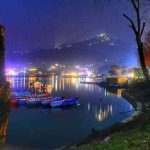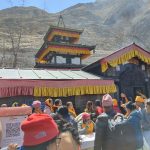Physical Address
304 North Cardinal St.
Dorchester Center, MA 02124

Chitwan National Park, formerly known as Royal Chitwan National Park, Nepal’s first national park, is a UNESCO World Heritage Site renowned for its rich biodiversity and vibrant ecosystems. Located in the Chitwan, Parsa, and Nawalpur districts of south-central Nepal, The park’s name, “Chitwan,” means “Heart of the Jungle,”. The park covers an area of 932 square kilometers (360 square miles) and it is bordered by the Rapti River to the north, the Narayani River to the west, and the Parsa Wildlife Reserve to the east. Established in 1973, Chitwan National Park has become one of the most popular destinations for wildlife enthusiasts and eco-tourists. We will provide a detailed exploration of the park’s unique features, wildlife, cultural significance, and conservation efforts.
The landscape of Chitwan National Park is characterized by a mix of dense tropical forests, grasslands, and riverine ecosystems. The park lies in the Terai-Duar savanna and grasslands ecoregion, with altitudes ranging from 100 meters to 815 meters above sea level. The park’s terrain includes the floodplains of the Rapti, Narayani, and Reu rivers, creating a rich mosaic of habitats.
The northern part of the park is dominated by the Churia Hills, which rise to about 815 meters and serve as a natural barrier, protecting the park from northern climatic influences. The park’s varied landscape supports a wide range of plant and animal species, making it one of the most biologically diverse areas in Nepal.
Chitwan National Park is a biodiversity hotspot, hosting a vast array of flora and fauna, including several endangered species. The park’s diverse habitats provide a refuge for numerous mammals, birds, reptiles, and plant species.
Chitwan National Park’s vegetation is predominantly tropical and subtropical, with a variety of plant species. The park’s forests are primarily composed of Sal trees (Shorea robusta), which cover about 70% of the park’s area. The remaining areas include riverine forests, grasslands, and wetlands. The park’s grasslands, known locally as Phanta, provide critical habitat for herbivores like the rhinoceros and various deer species.
The Chitwan region is inhabited by various ethnic communities, including the Tharu, Tamang, Bote, and Majhi people. The Tharu people, in particular, have a long-standing cultural and spiritual connection with the land. Known for their unique traditions, art, and dance, the Tharu community plays a crucial role in the park’s cultural landscape.
The traditional mud houses of the Tharu, adorned with intricate designs, are a distinctive feature of the region. The Tharu culture is rich in folklore, music, and dance, often depicting wildlife and natural elements. Visitors to the park can experience Tharu cultural programs and visit traditional villages, gaining insights into their way of life.
October to March: The best time to visit Chitwan National Park is during the dry season. During this period, the weather is pleasant, and the visibility is excellent for wildlife viewing. The cooler temperatures also make it comfortable for outdoor activities such as safaris and nature walks.
The summer monsoon season (June to September): In this season, the weather brings heavy rainfall, which can make some areas of the park inaccessible and wildlife viewing more challenging. However, the park is lush and vibrant during this time, with abundant vegetation and water sources.
Chitwan National Park offers a range of activities for visitors, making it a popular destination for wildlife enthusiasts and adventure seekers.
Jungle safaris, either by jeep or on elephant back, are one of the most popular activities in Chitwan National Park. These safaris offer a chance to see a wide variety of wildlife, including the one-horned rhinoceros, Bengal tigers, and various bird species. Guided safaris are available, led by experienced naturalists and local guides.
Canoeing on the Rapti and Narayani rivers is a unique way to explore the park’s riverine ecosystems. This activity offers opportunities to spot waterfowl, crocodiles, and other wildlife along the riverbanks. It is a serene and peaceful experience, allowing visitors to immerse themselves in the park’s natural beauty.
With over 540 species of birds, Chitwan National Park is a birdwatcher’s paradise. The park’s diverse habitats provide opportunities to spot both resident and migratory bird species. The best time for bird watching is during the winter months when migratory birds arrive.
Nature walks, led by experienced guides, allow visitors to explore the park’s flora and fauna on foot. These walks offer a more intimate experience, with opportunities to observe wildlife and learn about the park’s ecosystems. The Elephant Breeding Center, located within the park, provides insights into the life and conservation of Asian elephants.
Chitwan National Park offers a range of accommodation options, from luxury resorts to budget guesthouses and community-run lodges. Many accommodations are located in Sauraha, the main gateway to the park, and offer various amenities such as restaurants, cultural programs, and wildlife safaris.
The park’s headquarters at Kasara provides visitor information, permits, and a small museum. Several lodges and resorts within the park also offer guided tours, safaris, and cultural experiences.
Chitwan National Park is a protected area, and various conservation efforts are in place to preserve its unique ecosystems and wildlife. The park authorities work closely with local communities and conservation organizations to address challenges such as habitat loss, poaching, and human-wildlife conflict.
The park is part of the Terai Arc Landscape, a transboundary conservation initiative aimed at preserving the biodiversity and cultural heritage of the Terai region. Community-based conservation programs are an integral part of the park’s management strategy, involving local communities in sustainable tourism and resource management practices.
A visit to Chitwan National Park requires some planning, especially given the remote location and the need for appropriate permits. Here are some tips to help you prepare:
Chitwan National Park, with its rich biodiversity, vibrant ecosystems, and cultural heritage, offers a unique and immersive experience for visitors. Whether you’re on a jungle safari in search of one-horned rhinoceroses, bird watching in the wetlands, or exploring the cultural traditions of the Tharu people, the park provides endless opportunities for exploration and adventure. By supporting conservation efforts and engaging with the local communities, visitors can contribute to the preservation of this incredible natural treasure for future generations to enjoy.
“Chitwan National Park is a wildlife lover’s paradise, offering thrilling safaris and rich biodiversity.”



